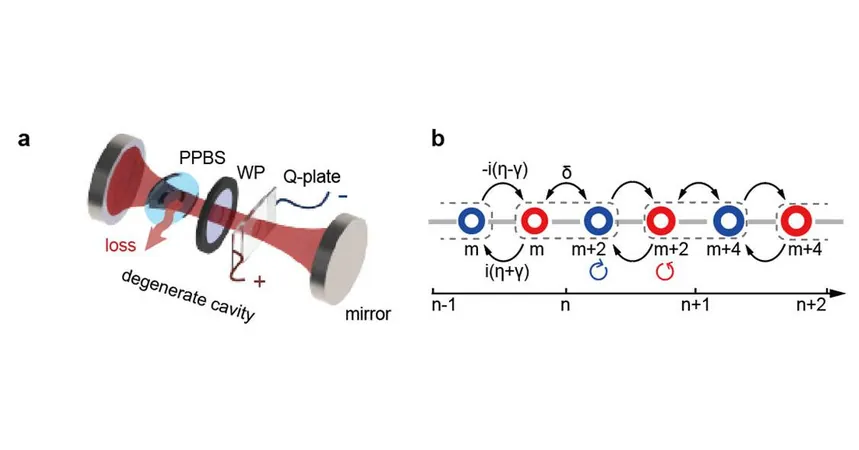
Breakthrough in Non-Hermitian Topology: Scientists Discover Half-Integer Winding Numbers!
2025-06-26
Author: Daniel
A Quantum Leap in Non-Hermitian Topology
In a groundbreaking study, a team of visionary scientists from China has unveiled a remarkable non-Hermitian topological lattice, tapping into the synthetic dimension of orbital angular momentum (OAM). This innovative approach is poised to redefine our understanding of non-Hermitian systems, demonstrating the elusive half-integer winding numbers of eigenstates and unveiling their corresponding edge states on semi-infinite chains.
Why Non-Hermitian Systems Matter
Typically, quantum mechanics relies on Hermitian observables for real eigenvalues, yet real-world interactions lead to non-Hermitian characteristics due to factors like dissipation and openness. This crucial shift has propelled the development of non-Hermitian theory, serving as a vital framework for understanding open systems and non-equilibrium topological phases.
Exploring Exotic Topological States
The realm of non-Hermitian systems has recently erupted with exotic topological states, beckoning researchers to extend traditional concepts into this fascinating territory. These non-Hermitian topological systems reveal groundbreaking phenomena, such as unique topological classifications and the captivating non-Hermitian skin effect, challenging established paradigms.
The Research Breakthrough
Professors Chuan-Feng Li, Jin-Shi Xu, Xi-Wang Luo, and postdoctoral researcher Mu Yang from the University of Science and Technology of China (USTC) have set a new standard in experimental physics. By innovatively constructing a synthetic lattice that utilizes OAM, they successfully observed and documented the winding behaviors of eigenenergies and eigenstates, marking a historic first: the experimental observation of half-integer topological winding numbers in non-Hermitian systems.
Understanding the Connection to Boundary States
Professor Jinshi Xu highlights the significance of these findings: “Topological winding numbers serve as critical invariants in non-Hermitian systems, intricately linked to the system's underlying symmetries.” The study also elucidates the traditional correspondence between topological invariants and boundary states, which is intriguingly disrupted by non-Hermitian effects, particularly the skin effect.
Innovative Experimental Design
The research team ingeniously engineered a resonator capable of supporting multiple OAM modes. By utilizing q-plates and wave plates within the cavity, they orchestrated a coupling between orbital and spin angular momentum states. This design led to the realization of a non-Hermitian synthetic OAM lattice, incorporating crucial factors that instigate the non-Hermitian skin effect.
The First Experimental Confirmation
In a landmark achievement, the researchers employed advanced methods to measure winding numbers, achieving unprecedented results in the experimental study of non-Hermitian topology. Their work, published in "Light: Science & Applications," not only confirms the existence of half-integer topological invariants but also establishes a tangible link to boundary states.
Implications for Future Research
This promising research paves the way for new explorations in non-Hermitian topological physics, opening doors to potential applications in advanced photonic devices. With ongoing work building on earlier significant contributions to the field, the future looks bright for understanding the complex interplay between topology and quantum mechanics.
Join the Revolution in Quantum Physics!
As the boundaries of physics are pushed further, this breakthrough holds the potential to become a staple in the toolkit of researchers delving into the mysteries of non-Hermitian systems. Keep your eyes peeled for what comes next!





 Brasil (PT)
Brasil (PT)
 Canada (EN)
Canada (EN)
 Chile (ES)
Chile (ES)
 Česko (CS)
Česko (CS)
 대한민국 (KO)
대한민국 (KO)
 España (ES)
España (ES)
 France (FR)
France (FR)
 Hong Kong (EN)
Hong Kong (EN)
 Italia (IT)
Italia (IT)
 日本 (JA)
日本 (JA)
 Magyarország (HU)
Magyarország (HU)
 Norge (NO)
Norge (NO)
 Polska (PL)
Polska (PL)
 Schweiz (DE)
Schweiz (DE)
 Singapore (EN)
Singapore (EN)
 Sverige (SV)
Sverige (SV)
 Suomi (FI)
Suomi (FI)
 Türkiye (TR)
Türkiye (TR)
 الإمارات العربية المتحدة (AR)
الإمارات العربية المتحدة (AR)